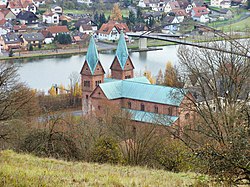Neustadt am Main Abbey
| Kloster Neustadt am Main | |

St. Michael und Gertrud, the former abbey church
|
|
| Monastery information | |
|---|---|
| Order | Benedictines |
| Established | 8th century |
| Disestablished | 1803 |
| Site | |
| Location | Neustadt am Main, Germany |
| Coordinates | 49°55′48″N 9°34′13″E / 49.93000°N 9.57028°ECoordinates: 49°55′48″N 9°34′13″E / 49.93000°N 9.57028°E |
| Public access | partial |
Neustadt am Main Abbey (German: Kloster Neustadt am Main) was an abbey of the Benedictine Order in Neustadt am Main, Bavaria, Germany. It existed from the 8th century until the dissolution of abbeys in the course of secularization in 1803. During its heyday in the early Middle Ages, the abbey was a political power that vied for regional influence with the Prince-bishops of Würzburg, the Archbishops of Mainz and the Counts of Rieneck. Today its location is occupied by a (mostly newly constructed) monastery operated by the nuns of the "Dominican Order of Saint Catherine of Siena", also known as Kloster Neustadt. The former abbey church today serves as the Catholic parish church for Neustadt.
A Benedictine abbey here was first mentioned (Niwenstat) in a document from 768/769, when Megingoz, second Bishop of Würzburg, retired from his post to found a monastery at what is today known as Michaelsberg, referred to in historic sources as Rorinlacha. This location apparently marked a Frankish hunting lodge, gifted by a local count, Hatto. Reportedly, the consecration of the abbey church in 793 was attended by Charlemagne, Willibald, Bishop of Eichstätt and Lullus, Archbishop of Mainz (although the latter in fact died in 786). Berowelf, who succeeded Megingoz as Bishop of Würzburg, sent 50 monks to join him at this Nivenstat or Nuovenstatt ("new place").
To establish the new foundation's independence from Würzburg, Megingoz succeeded in making it a Königskloster, chartered by the Franconian king and not subject to control by a bishop. The Royal charter issued in 794 has been lost, a document long held to be the foundation charter was later discovered to be a forgery from c. 1200. However, Charlemagne is known to have supported the abbey financially and gifted it with large properties in the nearby Spessart hills.
...
Wikipedia

